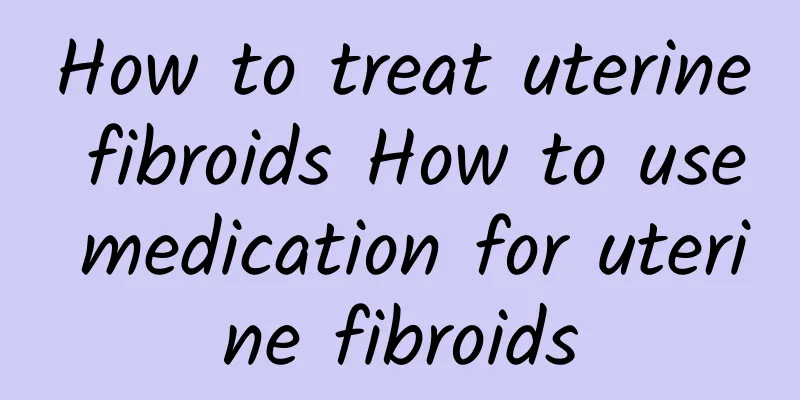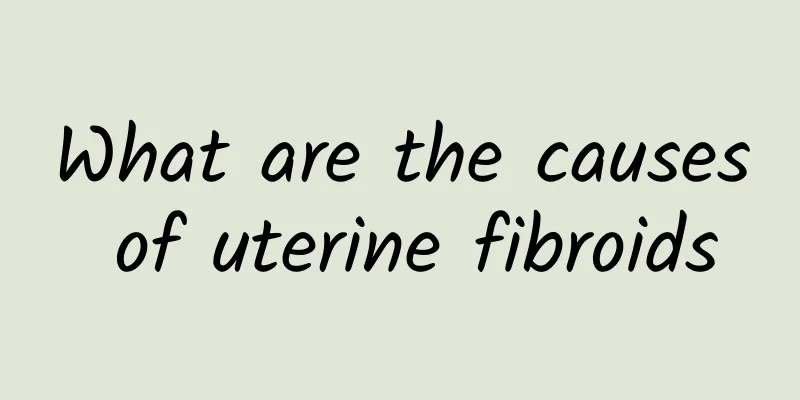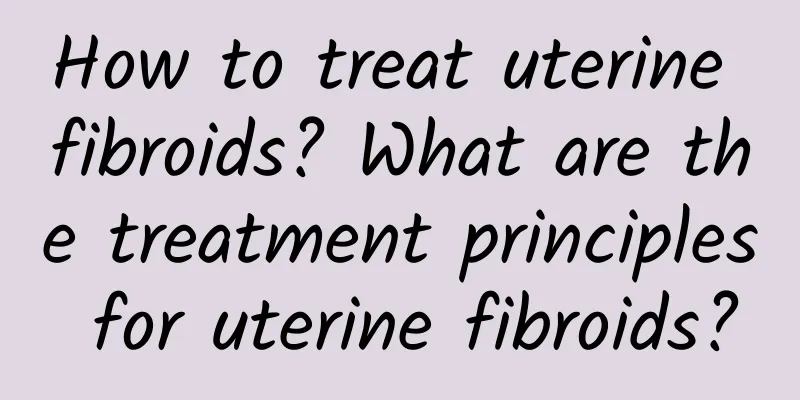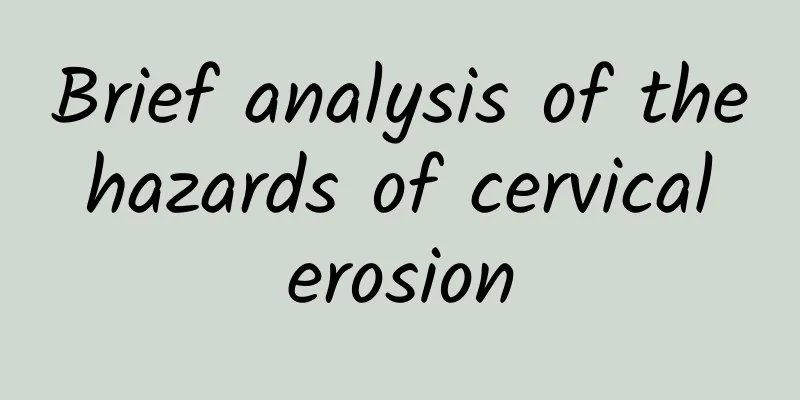How to treat uterine fibroids How to use medication for uterine fibroids

|
It is very harmful for women to suffer from uterine fibroids. Today's society is developing rapidly. People usually need to pay attention to women's physical changes and the occurrence of this disease. In daily life, we should pay attention to reasonable treatment, observe the patient's physical changes, and cure the disease as soon as possible to avoid more impacts. What are the treatments for uterine fibroids? 1. Follow-up observation If the patient has no obvious symptoms and no symptoms of malignancy, regular follow-up observation can be performed. 2. Medication (1) Gonadotropin-releasing hormone agonist (GnRH-a) Commonly used GnRH-a in clinical practice include leuprorelin (Enanton), goserelin (Zoloft), triptorelin (Dapiga), etc. GnRH-a should not be used for a long time and is only used for preoperative pretreatment, generally for 3 to 6 months, to avoid causing severe menopausal symptoms caused by low estrogen; small doses of estrogen can also be supplemented to resist this side effect. (2) Mifepristone is a progesterone antagonist that has been clinically used in the treatment of uterine fibroids in recent years. It can reduce the size of fibroids, but the fibroids grow more after discontinuation of the drug. (3) Danazol is used for preoperative medication or to treat uterine fibroids that are not suitable for surgery. Uterine fibroids can grow after the drug is stopped. Taking danazol causes liver damage and androgenic side effects (weight gain, acne, deepening of the voice, etc.). (4) Tamoxifen can inhibit the growth of fibroids. However, it should be noted that some patients may experience an increase in the response of uterine fibroids, and may even induce endometriosis and endometrial cancer. (5) Commonly used androgen drugs include methyltestosterone (methyltestosterone) and testosterone propionate (testosterone propionate), which can inhibit the growth of fibroids. Pay attention to the dosage to avoid masculinization. During the bleeding period of patients with uterine fibroids, if the amount of bleeding is heavy, uterine contractants (such as oxytocin, ergot) and hemostatic drugs (such as hemostatic acid, aminobenzoic acid (hemostatic aromatic acid), lizhihemostasis, Panax notoginseng tablets, etc.) can also be used, which can play a certain degree of auxiliary hemostatic effect. 3. Surgery Surgical treatment of uterine fibroids includes myomectomy and hysterectomy, which can be performed abdominally, vaginally, or endoscopically (hysteroscopy or laparoscopy). The choice of surgery and surgical method depends on factors such as the patient's age, fertility requirements, size of the fibroid, location of growth, and medical technology conditions. (1) Myomectomy: The surgery to remove uterine fibroids and preserve the uterus is mainly used for young women under 40 who wish to retain their fertility. It is suitable for patients with large fibroids, heavy menstruation, compression symptoms, infertility caused by fibroids, submucosal fibroids, and rapidly growing fibroids without malignant transformation. (2) Patients with obvious symptoms of hysterectomy, the possibility of malignant changes in fibroids, and no fertility requirements are suitable for hysterectomy. Hysterectomy can be performed by total hysterectomy or subtotal hysterectomy. Patients of older age are suitable for total hysterectomy. The possibility of cervical malignancy must be eliminated before surgery. (3) Uterine artery embolization uses radiological intervention to insert an arterial catheter directly into the uterine artery, inject permanent embolic particles, block the blood supply to the uterine fibroids, and achieve fibroid shrinkage or even disappearance. UAE is currently mainly suitable for uterine fibroids with symptoms such as anemia caused by abnormal uterine bleeding. When choosing interventional treatment for uterine fibroids, caution should be exercised, especially for patients with uncontrolled pelvic inflammation, patients who wish to retain fertility, arteriosclerosis, and contraindications to angiography should be listed as contraindications to this treatment. 5% of patients may have premature ovarian failure and rare pelvic infections after surgery. 4. Focused Ultrasound Therapy The temperature inside the tumor is raised locally to above 65°C, causing coagulative necrosis of the tumor and exerting a therapeutic effect. The treatment can shrink the fibroids and relieve symptoms. It is suitable for symptomatic uterine fibroids. There are no surgical scars after treatment, and the advantages are fast recovery after surgery. Side effects include skin burns, intestinal damage, hematuria, etc. |
<<: How to treat multiple uterine fibroids? How to use medicine for multiple uterine fibroids
Recommend
Is there any difference between surgical abortion and painless abortion? How much does it cost?
Medical technology is becoming more and more adva...
Which women are not suitable for medical abortion?
Experts say that although medical abortion is a g...
Knowing the symptoms of vulvar leukoplakia can help detect the patient's condition as early as possible
With the continuous changes in living environment...
Eat ginseng and red dates every day to improve your health? 8 common Chinese medicinal materials landmines, stepping on them by mistake will make you cry
Think about it, what Chinese medicinal herbs do y...
What are the causes of moderate cervical erosion? Moderate cervical erosion is related to these factors
Everyone should be familiar with cervical erosion...
How should patients with endometriosis eat?
There are many factors that lead to endometriosis...
Will chronic cervicitis affect pregnancy?
Will chronic cervicitis affect pregnancy? 1. Chro...
Is a low-sugar, high-fat diet good or bad for losing weight?
In the famous movie "Golden Chicken", t...
Can I still get pregnant after ectopic pregnancy surgery?
Ectopic pregnancy brings great harm to women, not...
What are the treatments for menopause?
After suffering from menopause, the diet of menop...
Will Bartholinitis affect life expectancy?
Bartholinitis is a problem that many women have e...
What preparations do you need to make before a curettage? How long does a curettage take?
The main purpose of curettage is to further remov...
What are the most effective treatments for acute pelvic inflammatory disease?
Pelvic inflammatory disease is a gynecological di...
Does cervical erosion need treatment?
Generally speaking, mild cervical erosion without...
What is the TCM dialectical treatment method for chronic cervicitis in women? Three major Chinese medicine prescriptions for treating chronic cervicitis in women
Chronic cervicitis is a very common gynecological...









